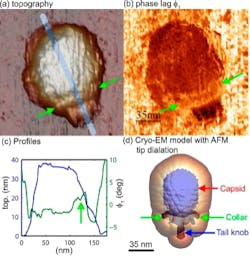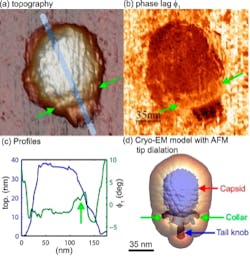Discovery to aid study of biological structures, molecules
WEST LAFAYETTE, IN, Aug. 11, 2009 -- Researchers in the United States and Spain have discovered that a tool widely used in nanoscale imaging works differently in watery environments, a step toward better using the instrument to study biological molecules and structures.
"People using this kind of instrument to study biological structures need to know how it works in the natural watery environments of molecules and how to interpret images," he said.
An atomic force microscope uses a tiny vibrating probe to yield information about materials and surfaces on the scale of nanometers, or billionths of a meter. Because the instrument enables scientists to "see" objects far smaller than possible using light microscopes, it could be ideal for studying molecules, cell membranes and other biological structures.
The best way to study such structures is in their wet, natural environments. However, the researchers have now discovered that in some respects the vibrating probe's tip behaves the opposite in water as it does in air, said Purdue mechanical engineering doctoral student John Melcher.
Purdue researchers collaborated with scientists at three institutions in Madrid, Spain: Universidad Autónoma de Madrid, Instituto de Ciencia de Materiales de Madrid and the Centro Nacional de Biotecnología.
Findings, which were detailed in a paper appearing online last week in the U.S. publication Proceedings of the National Academy of Sciences, are related to the subtle differences in how the instrument's probe vibrates. The probe is caused to oscillate by a vibrating source at its base. However, the tip of the probe oscillates slightly out of synch with the oscillations at the base. This difference in oscillation is referred to as a "phase contrast," and the tip is said to be out of phase with the base.
Although these differences in phase contrast reveal information about the composition of the material being studied, data can't be properly interpreted unless researchers understand precisely how the phase changes in water as well as in air, Raman said.
If the instrument is operating in air, the tip's phase lags slightly when interacting with a viscous material and advances slightly when scanning over a hard surface. Now researchers have learned the tip operates in the opposite manner when used in water: it lags while passing over a hard object and advances when scanning the gelatinous surface of a biological membrane.
Researchers deposited the membrane and viruses on a sheet of mica. Tests showed the differing properties of the inner and outer sides of the membrane and details about the latticelike protein structure of the membrane. Findings also showed the different properties of the balloonlike head, stiff collar and hollow tail of the Phi29 virus, called a bacteriophage because it infects bacteria.
"The findings suggest that phase contrast in liquids can be used to reveal rapidly the intrinsic variations in local stiffness with molecular resolution, for example, by showing that the head and the collar of an individual virus particle have different stiffness," Raman said.
The research was funded by the National Science Foundation and was conducted at the Birck Nanotechnology Center in Purdue's Discovery Park. The biological membrane images were taken at Purdue, and the virus studies were performed at the Universidad Autónoma de Madrid.
The paper was authored by Melcher; Carolina Carrasco, a postdoctoral researcher at Universidad Autónoma de Madrid and the Instituto de Ciencia de Materiales de Madrid; Purdue postdoctoral researcher Xin Xu; José L. Carrasco, a researcher at Departmento de Estructura de Macomoléculas, Centro Nacional de Biotecnología, Consejo Superior de Investigaciones Científicas; Julio Gómez-Herrero and Pedro José de Pablo, both researchers from Universidad Autónoma de Madrid; and Raman.
###

